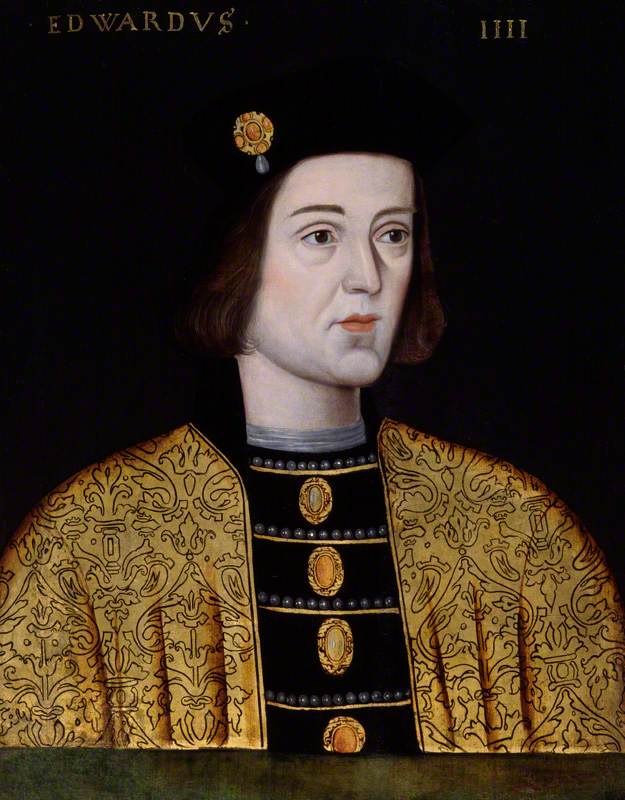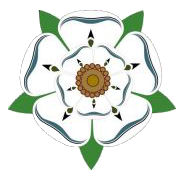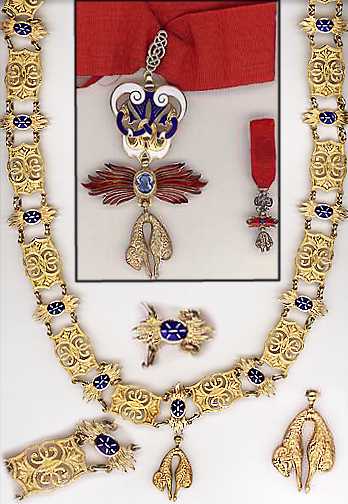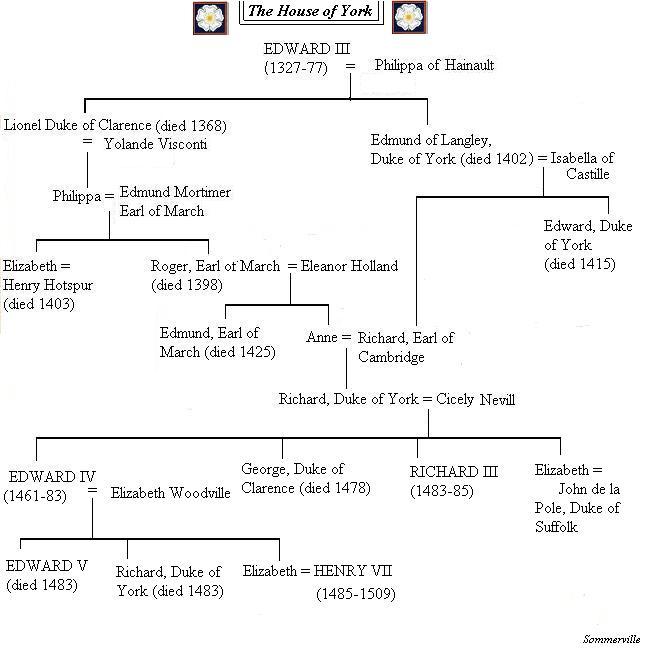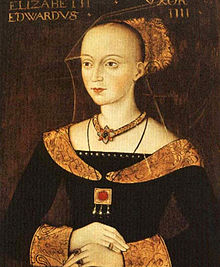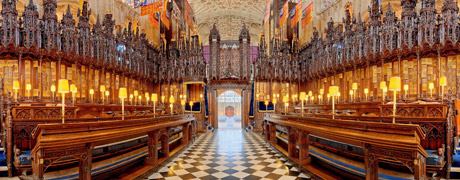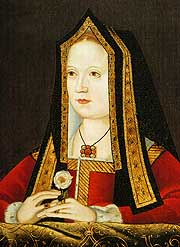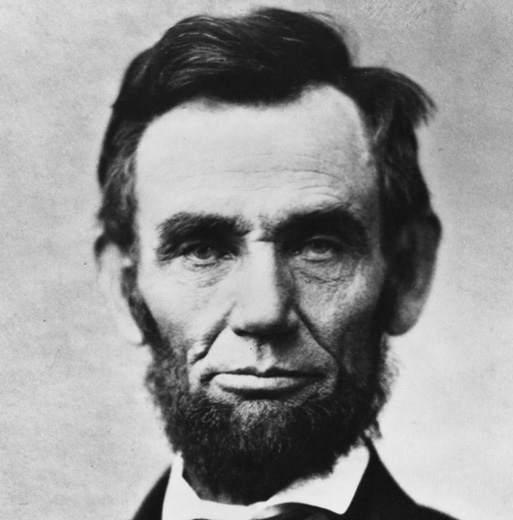Name: King Edward IV
Born: April 28, 1442 at Rouen, France
Parents: Richard, Duke of York, and Cecily Neville
Relation to Elizabeth II: 14th great-grandfather
House of: York
Ascended to the throne: March 4, 1461 aged 18 years
Crowned: June 28, 1461 at Westminster Abbey
Married: Elizabeth, Daughter of Richard Woodville
Children: Three sons including Edward V and Richard Duke of York (the Princes in the Tower), Seven daughters and four illegitimate children
Died: April 9, 1483 at Westminster Abbey, aged 40 years, 11 months, and 11 days
Buried at: Windsor
Reigned for: 21 years, 5 months, and 18 days, Deposed October 3, 1470, Restored May 21, 1471
Succeeded by: his son Edward V
King of England 1461–70 and from 1471. He was the son of Richard, Duke of York, and succeeded Henry VI in the Wars of the Roses, temporarily losing his throne to Henry when Edward fell out with his adviser Richard Neville, Earl of Warwick. Edward was a fine warrior and intelligent strategist, with victories at Mortimer’s Cross and Towton in 1461, Empingham in 1470, and Barnet and Tewkesbury in 1471. He was succeeded by his son Edward V.
Edward was known as Earl of March until his accession. After his father’s death he occupied London 1461, and was proclaimed king in place of Henry VI by a council of peers. His position was secured by the defeat of the Lancastrians at Towton 1461 and by the capture of Henry. He quarrelled, however, with Warwick, his strongest supporter, who in 1470–71 temporarily restored Henry, until Edward recovered the throne by his victories at Barnet and Tewkesbury.
| Timeline for King Edward IV |
| 1461 | Edward, son of Richard of York, is declared king by the Earl of Warwick following the Yorkist victory at the Battle of Towton. |
| 1464 | Warwick defeats Lancastrians at Battle of Hexham; Henry VI is captured and brought to the Tower of London. |
| 1464 | Edward marries Elizabeth Woodville, the widow of a commoner, offending Warwick. |
| 1469 | Warwick falls out with Edward IV, and defeats him at Edgecote. They are later reconciled but Warwick is banished. He makes peace with Margaret, returns to England with an army, and Edward flees to Flanders. Henry VI is restored to the throne. |
| 1471 | Edward returns to England from Flanders and defeats and kills Warwick at the Battle of Barnet. |
| 1471 | Margaret is defeated at the Battle of Tewkesbury and the Lancastrian heir, Prince Edward, is killed. Soon after, Henry VI is murdered in the Tower of London. |
| 1474 | Edward grants privileges to the Hanseatic League of North German trading cities to conduct trade in England. |
| 1476 | William Caxton sets up a printing press in Westminster, London |
| 1478 | Edward falls out with his brother George, Duke of Clarence, who is then murdered in the Tower, supposedly in a butt of malmsey wine. |
| 1483 | Death of Edward. |
Edward IV (28 April 1442 – 9 April 1483) was King of England from 4 March 1461 until 3 October 1470, and again from 11 April 1471 until his death in 1483. He was the first Yorkist King of England. The first half of his rule was marred by the violence associated with the Wars of the Roses, but he overcame the Lancastrian challenge to the throne at Tewkesbury in 1471 to reign in peace until his sudden death. Before becoming king he was 4th Duke of York, 7th Earl of March, 5th Earl of Cambridge and 9th Earl of Ulster. He was also the 65th Knight of the Order of the Golden Fleece.
The Order of the Golden Fleece was established January 10, 1430, by Philip the Good, Duke of Burgundy, in celebration of the prosperous and wealthy domains united in his person that ran from Flanders to Switzerland. It is restricted to a limited number of knights, initially 24 but increased to 30 in 1433, and 50 in 1516, plus the sovereign.
It received further privileges unusual to any order of knighthood: the sovereign undertook to consult the order before going to war; all disputes between the knights were to be settled by the order; at each chapter the deeds of each knight were held in review, and punishments and admonitions were dealt out to offenders, and to this the sovereign was expressly subject; the knights could claim as of right to be tried by their fellows on charges of rebellion, heresy and treason, and Charles V conferred on the order exclusive jurisdiction over all crimes committed by the knights; the arrest of the offender had to be by warrant signed by at least six knights, and during the process of charge and trial he remained not in prison but in the gentle custody of his fellow knights. The order, conceived in an ecclesiastical spirit in which mass and obsequies were prominent and the knights were seated in choirstalls like canons, was explicitly denied to “heretics”, and so became an exclusively Catholic award during the Reformation.
The Duke’s stated reason for founding this institution had been given in a proclamation issued following his marriage, in which he wrote that he had done so “for the reverence of God and the maintenance of our Christian Faith, and to honor and exalt the noble order of knighthood, and also …to do honor to old knights; …so that those who are at present still capable and strong of body and do each day the deeds pertaining to chivalry shall have cause to continue from good to better; and .. so that those knights and gentlemen who shall see worn the order … should honor those who wear it, and be encouraged to employ themselves in noble deeds…”.
The Order of the Golden Fleece was defended from possible accusations of prideful pomp by the Burgundian court poet Michault Taillevent, who asserted that it was instituted:
Non point pour jeu ne pour esbatement,
Mais à la fin que soit attribuée
Loenge à Dieu trestout premièrement
Et aux bons gloire et haulte renommée.
The House of York
The House of York displaced that of Lancaster on the throne of England after the decisive Yorkist victory at of the Battle of Towton in 1461. One of the badges of the house was the white rose. Edward IV, the first King of the House of York, was the eldest son of Richard Plantagenet, Duke of York, descendant of Lionel, Duke of Clarence, third son of Edward III.
The House of York produced three Kings of England, Edward IV left the crown to his young son, Edward V, the elder of the Princes in the Tower but the throne was usurped by his uncle, who became Richard III. The young Edward V and his brother, Richard, Duke of York, disappeared into the depths of the Tower of London and were never seen alive again.
At The Battle of Bosworth in 1485, Richard III, last of the Plantagenet kings, was killed in battle and the throne passed to the House of Tudor, as a conciliatory gesture, Henry married Edward IV’s eldest daughter and heiress, Elizabeth of York.
Parentage and Early Life
England’s first Yorkist King, Edward IV, was the eldest surviving son of Richard Plantagenet, Duke of York and Cecily Neville and was born on 22nd April, 1442 at Rouen, whilst the Duke was stationed there.
His father, Richard Plantagenet, Duke of York, held a strong claim to the English throne, he was the son of Richard, Earl of Cambridge, who himself was the son of Edward III’s fourth surviving son, Edmund of Langley, Duke of York. Richard of York’s mother Anne Mortimer, was the great grandaughter and heiress of Phillipa Plantagenet, the only child of Lionel, Duke of Clarence, second surviving son of Edward III. Richard II had declared Anne’s father, Roger Mortimer, 4th Earl of March, as heir presumptive to the crown. Edward’s mother, Cecily Neville, was the daughter of Ralph Neville, 1st Earl of Westmorland, and Joan Beaufort, daughter of John of Gaunt, 1st Duke of Lancaster and his mistress, later wife, Katherine Swynford.
On the death of his father and brother, Edmund, Earl of Rutland, in contest for the throne, at Sandal Castle, at Christmas, 1460, Edward inherited from his father the Yorkist claim to England’s throne. He acquired the support of his powerful cousin, Richard Neville, Earl of Warwick, later to be known to history as Warwick the Kingmaker. Edward proved to be an able general, defeating the Lancastrians at Mortimers Cross in February 1461 after which he was proclaimed king in London. He gained a further decisive victory over the Lancastrians at Towton in Yorkshire, on 29th March, Palm Sunday. Fought in a snowstorm, it was to be the bloodiest battle of the Wars of the Roses, with casualties reported to be in the region of 50,000-60,000. The victorious Edward made a state entry into London in June and was crowned King of England at Westminster.
Edward’s appearance
 King Edward IV was a tall man, at six feet four inches high and said to be extremely good looking.
King Edward IV was a tall man, at six feet four inches high and said to be extremely good looking.
Thomas More records of Edward:-
‘ He was a goodly personage and very princely to behold; of heart courageous, politic in counsel, in adversity nothing abashed, in prosperity rather joyful than proud, in peace just and merciful, in war sharp and fierce, in the field bold and hardy, and nevertheless no further than wisdom would, adventurous.
More goes on to add ‘ He was of visage lovely; of body mighty, strong and clean made; howbeit in his latter days, with over liberal diet, somewhat corpulent and burly but nevertheless noy uncomely. He was in youth greatly given to fleshy wantoness, from which health of body in great prosperity and fortune, without a special grace, hardly refrains.’
The extrovert Edward was popular with the people, especially the Londoners and the ladies. Inclined to be lazy and easy going, he could act with alacrity when necessary and was highly efficient, although possessed of the ruthless streak that was inherent in the House of York.
Reign
On becoming king at nineteen years old, Edward met and secretly married Elizabeth Woodville, the widow of Sir John Grey, a Lancastrian knight and daughter of Sir Richard Woodville (later Earl Rivers) and Jacquetta of Luxembourg. She had come to petition him for the restoration of her son’s estates, the King had wanted her to become his mistress, but she refused. Bewitched by her beauty, he finally proposed, they were married at the Manor of Grafton in Northamptonshire on 1 May 1464. Elizabeth had two sons from her first marriage, Thomas, later created Marquess of Dorset, and Richard Grey.
Elizabeth, who proved to be avaricious and grasping, quickly persuaded her besotted spouse to arrange advantageous marriages amongst the nobility for her large and needy family. This succeeded in alienating ‘the over mighty subject’ Warwick, turning him from Edward’s supporter to his implacable enemy.
Edward’s brother, George, Duke of Clarence also heartily disliked the new Queen. Warwick, who possessed influence over George and under whom he had been brought up, wished to arrange a marriage between him and his eldest daughter and co-heiress, Isabel. The King refused to sanction the match, in defiance of his brother, Clarence married Isabel at Calais.
Warwick ‘The Kingmaker’
Further ill-feeling and suspicion being engendered on both sides culminated in Warwick and Clarence’s open revolt, Edawrd’s forces were defeated by them at the Battle of Edgecote Moor in 1469, and the king himself captured, Warwick attempted to rule England in Edward’s name, but a counter rebellion forced the king’s release.
Despite attempts at reconciliation on Edward’s part, Warwick and Clarence headed a further rebellion in 1470. They were defeated and forced to join Margaret of Anjou in France. Warwick entered into an alliance with the Lancastrians agreeing to restore the deposed Henry VI in exchange for French support. This alliance was sealed by the marriage of Warwick’s younger daughter, Anne Neville to Edward, the Lancastrian Prince of Wales. On their subsequent invasion , Warwick’s powerful brother, John Neville, 1st Marquess of Montagu, also switched his alleigance to the Lancastrians. Edward, along with his loyal younger brother, Richard, Duke of Gloucester, was forced to flee to the continent, taking refuge in Burgundy and Henry VI was briefly restored to the throne in 1470, little more than the puppet of the ambitious Warwick.
During Henry VI’s restoration, Queen Elizabeth took sanctuary at Westminster Abbey where she gave birth to the Yorkist Prince of Wales, Edward. Warwick and Clarence had parliament disinherit Edward IV and his heirs, they claimed the king was not the true son of the Duke of York, but the product of Duchess Cecily’s liaison with an archer named Blackburn, who was in the employ of the Duke of York when he was stationed in France.
Edward’s brother-in-law, Charles, Duke of Burgundy, was initially unwilling to offer him support, however, a French declaration of war on the province forced his hand and Edward was equiped with a small army, in attempt to regain the throne. Following the example of Henry of Bolingbroke some seventy years previously, Edward, a daring military commander, at first claimed he had returned to England merely to claim his duchy of York, the city of York, however, refused to admit him but supporters flocked to his banner as he proceeded to march south. When Clarence, Shakespeare’s ‘quicksand of deceit’, demoted again to second in line to the throne, realised he had gained nothing from his abandonment of his brother, he promptly switched sides, rejoining Edward’s forces at the Battle of Barnet, to ensure that he, Clarence, was on the winning side. The Lancastrian forces were defeated in the ensuing battle, which was fought in thick fog and the mighty Warwick himself slain whilst fleeing the battlefield.
The same day Margaret of Anjou and her seventeen year old son landed at Weymouth and began recruiting men to the Lancastrian cause. She made for Wales, hoping to join forces with her brother-in-law, Jasper Tudor, Earl of Pembroke, but Edward, marching his army hard on her heels caught up with her at Tewksbury on 4th May, 1471, where Edward, the Lancastrian Prince of Wales was slain, either during the battle or after and Margaret of Anjou taken prisoner. The Lancastrian cause had reached its nadir. King Henry VI, a prisoner in the Tower of London , met his death there a few days later, on the night of the Vigil of the Ascension, 21st – 22nd May, 1471. The demise of his son had sealed his fate. While Edward of Lancaster still lived, he rendered the removal of Henry pointless. The Yorkist version of his end, that he died of pure “melancholy and displeasure” on hearing on of his son’s death was not much accepted, even at the time. An examination of Henry’s skeleton in 1910 confirmed that he had died as a result of violence..
Richard, Duke of Gloucester, the youngest of the Yorkist brothers, wanted to marry Warwick’s younger daughter and co-heiress, Anne Neville, the widow of the Lancastrian Prince of Wales. Disputes arose with Clarence, who was married to Warwwick’s elder daughter, as to the inheritance and division of Warwick’s vast lands and property, despite the fact that his widow, who held these in her own right, was still alive. A notorious Act of Parliament decreeing that the Countess of Warwick should be treated as if she were legally dead, effectively solved the dispute.
Edward’s Achievements as King
An able ruler, Edward IV made an admirable start on reforming royal administration and on improving the machinery of royal finance. Edward embarked on an extensive building scheme, St. George’s Chapel at Windsor Castle, intended to be the mausoleum of the House of York. He patronised his rival King Henry VI’s foundation of Eton College, William Caxton set up England’s first printing press during the reign, and also received Edward’s patronage.
Edward revived the ancient claim of English Kings to the throne of France and set sail for France in the summer of 1475 with an army of around 10, 000. He possessed a powerful ally in Charles, Duke of Burgundy, the husband of his sister Margaret. The Treaty of Picquiny in 1475 brought the King a pension from Louis XI along with diplomatic benefits. Several of the king’s followers, which included his brother, Richard, Duke of Gloucester, considered the deal inglorious but Edward emerged with credit and had acquired a lucrative pension.
George, Duke of Clarence
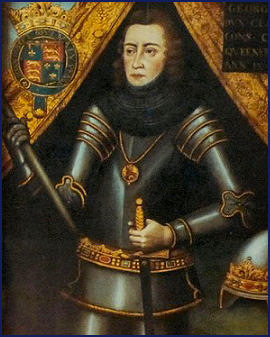 The King’s untrustworthy brother Clarence (pictured left) remained sullenly disatisfied, his wife Isabel Neville died shortly after giving birth in December, 1476, she was followed to the grave by her baby the following January. The death of women in or after childbirth was a common occurrence of the age, but Clarence, always inclined to be of a suspicious frame of mind and driven by a burning resentment of the Queen and her family, accused Ankarette Twynho, a woman who had waited on his wife, of poisoning her. A jury was bullied into deciding Ankarette guilty and the unfortunate woman was hung.
The King’s untrustworthy brother Clarence (pictured left) remained sullenly disatisfied, his wife Isabel Neville died shortly after giving birth in December, 1476, she was followed to the grave by her baby the following January. The death of women in or after childbirth was a common occurrence of the age, but Clarence, always inclined to be of a suspicious frame of mind and driven by a burning resentment of the Queen and her family, accused Ankarette Twynho, a woman who had waited on his wife, of poisoning her. A jury was bullied into deciding Ankarette guilty and the unfortunate woman was hung.
In retribution and as a warning, two of Clarence’s men were executed on a charge of using magical arts against the King and his family. Frustrated but unable to strike directly at the Queen, he burst into the council chamber at Westminster and read aloud a declaration of their innocence. The Duke of Clarence had clearly gone too far.
A rising in Cambridgeshire was believed to have been incited by Clarence, and Edward, whose patience had been tried to the limit, accused him of placing himself above the law when he tried and hung Ankarette Twynho. He was found guilty of high treason, attainted and the death sentence passed. At the request of his mother, Cecily Neville, Dowager Duchess of York, the execution was carried out privately in the Tower of London on 18th February, 1478. Rumour reported that he had been drowned in a butt of malmsey wine.
In his later years, due to over indulgence, Edward IV had put on much weight. He fell ill in March 1483 after catching a cold on a fishing trip on the Thames at Windsor, which is believed to have developed into pneumonia. On 9th April he died at Westminster and was buried in his foundation of St. George’s Chapel, Windsor, his tomb lies close to that of his victim, the Lancastrian King Henry VI. The tomb of King Edward IV was later destroyed by the Roundheads. He was suceeded by his twelve year old son, Edward V.
The fate of Elizabeth Woodville
Elizabeth Woodville lived on to see further reversals of fortune. The throne of her son Edward V was usurped by her brother-in-law, the Duke of Gloucester, who became Richard III and her marriage to Edward IV declared invalid and her children bastards. Her two young sons, Edward V and Richard, Duke of York, disappeared inside the grim walls of the Tower of London and were never again seen alive.
In attempt to regain her lost influence, she supported the Lancastrian Henry Tudor, promising him the hand of her eldest daughter, Elizabeth. After Henry’s defeat of Richard III at the Battle of Bosworth in 1485, he married Elizabeth of York , Elizabeth was restored to her position as Dowager Queen and stood as godparent to the new Tudor heir to the throne, her grandson, Prince Arthur.
For reasons that remain unclear, Elizabeth quarreled with her new son-in-law and was confined to a nunnery at Bermondsey in 1487. She died there, penniless on 8th June, 1492 and was buried beside her husband, Edward IV, at Windsor.
The Ancestry of Edward IV
| Edward IV | Father: Richard Plantagenet, Duke of York | Paternal Grandfather: Richard Plantagenet, Earl ofCambridge | Paternal Great-grandfather: Edmund Plantagenet Duke of York |
| Paternal Great-grandmother: Catherine of Valois | |||
| Paternal Grandmother: Anne Mortimer | Paternal Great-grandfather: Roger Mortimer, 4th Earl of March | ||
| Paternal Great-grandmother: Eleanor Holland | |||
| Mother: Cecily Neville | Maternal Grandfather: Ralph Neville, 1st Earl of Westmorland | Maternal Great-grandfather: John Neville, 3rd Baron Neville de Raby | |
| Maternal Great-grandmother: Maud Percy | |||
| Maternal Grandmother: Joan Beaufort | Maternal Great-grandfather: John of Gaunt, Duke of Lancaster | ||
| Maternal Great-grandmother: Katherine Swynford |
The children and grandchildren of Edward IV and Elizabeth Woodville
(1) Elizabeth of York (1466 – 1503) m. HENRY VII
(i) Arthur, Prince of Wales (b. 1486)
(ii) Margaret, Queen of Scotland (b.1489) m. (i)James IV King of Scots(ii)Archibald Douglas, Earl of Angus
(iii) HENRY VIII (b. 1491) m. (i) Catherine of Aragon (ii) Anne Boleyn (iii) Jane Seymour (iv) Anne of Cleves (v) Catherine Howard (vi) Catherine Parr
(iv) Elizabeth Tudor (died in infancy)
(v) Mary Tudor (b. 1496) m. (i) Louis XII, King of France (ii) Charles Brandon, Duke of Suffolk
(vi) Edmund Tudor (died in infancy)
(vii) Catherine Tudor (died in infancy)
(2) Mary (1467- 1482)
(3) Cecily (1469 – 1507) m. (i) John, Viscount Welles (ii) William Kyme
(4) EDWARD V (1470 – ?1483)
(5) Margaret (b. & d. 1472)
(6) Richard, Duke of York and Norfolk, Earl of Nottingham (1473 – ?1483) m. Anne Mowbray
(7) Anne (1476 – 1511) m. Thomas Howard, 3rd Duke of Norfolk
(8) George, Duke of Bedford (1477 – 1479)
(9) Catherine (1479 – 1527) m.William Courtenay
(i) Edward Courtenay, Earl of Devon (b. circa 1497 -executed 1539)
(ii) Henry Courtenay, Marquis of Exeter (b. circa 1497- executed 1539) m. (i) Elizabeth Grey (ii) Gertrude Blount
(iii) Margaret Courtenay (circa 1499 – 1526) m. Henry Somerset Lord Herbert
(10) Bridget , a nun (1480 – 1537)
Credits:
Wikipedia
http://www.englishmonarchs.co.uk/
http://www.britroyals.com/

